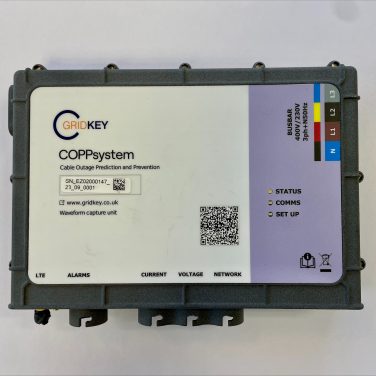Collaboration with SSEN and UK Power Networks to detect, classify and isolate low voltage faults before they cause disruption
Distribution Network Operators (DNOs) take their responsibility to deliver a safe, secure and reliable supply of electricity to customers seriously. They are working to identify smart, automated technologies which can increase network reliability and reduce the amount of time customers spend off supply. There is a lot of work to be done to ready the electricity network to supply three times the current demand and support a net zero future.
A proactive approach to managing faults on the grid
The traditional approach to finding faults has been reactive, relying upon investigations after a fault has occurred. Engineers dispatched to site may identify a fuse rupture and supply interruption, with standard practice being to replace the fuse. If the fault is not cleared then voltage and current analysis provide an approximate location of the fault, which is then pinpointed with gas sniffers and thermal cameras. However, this approach is only effective on simple networks and relies on finding faults after an event has occurred.
To make networks more resilient, DNOs are investing in monitoring the hundreds of thousands of low voltage substations and underground feeders that supply their customers. As part of a trial called Synchronous Analysis and Protection System (SYNAPS), Lucy Electric has collaborated with Scottish and Southern Electricity Networks (SSEN) and UK Power Networks to introduce automated procedures that use Machine Learning and Artificial Intelligence (AI) to analyse waveforms of network disturbances on LV feeders, to predict faults before they cause protection device or fuse operations. When network disturbances are detected, they are analysed and classified by specially developed algorithms to reveal the nature of the event and its precise location.
“When thinking about faults underground, one of the key challenges is that there’s not a lot of network and monitoring data,” explained Brian Lasslett at Lucy Electric. “SYNAPS creates a model of the network and uses that to stimulate the data. Real events can then be fed back in so AI can learn from it, a process referred to as deep learning.”
A precise way of discovering faults
Part one of SYNAPS was completed in 2019. The project successfully looked for and found faults in a controlled environment on a known radial network arrangement. SYNAPS 2 continued as a follow-up project trialling different network connections and configurations. It was also trialled on a more complex mesh network in London.
In total, 23 circuits are being monitored during the trial from December 2020 to March 2024. This includes sixteen circuits in the SSEN network, installed in Portsmouth, Southampton, Poole and Aberdeen, and 7 circuits in UK Power Networks’ network, in London. To date, out of the sites that have been monitored with sensors, around 300,000 events were recorded. Of these, only around 500 (1.5%) were classified as significant enough to warrant further investigation as SYNAPS can distinguish between problem events and false alarms. To date there have been 13 fault locations identified. Out of the fault locations identified 11 have been successfully excavated and validated as the cause of the fault, the other two are under investigation. SYNAPS can provide distance from substation and location, and, in the future, predictions of time-to-failure, with ever-increasing accuracy and probability.
“Learning from the project so far, indicates that the SYNAPS solution has potential to deliver significant CI and CML benefits by providing notifications of network events, that are indicative of degrading cables/joints, and providing highly probable fault locations to inform proactive repair decisions” commented Chino Atako, Senior Asset Engineer at UK Power Networks.
Early failure warnings
As part of the project, SSEN observed an event developing on its network in Portsmouth that had been ongoing for some time but had not caused any power cuts. SSEN chose to investigate further by proactively replacing and recovering the section of cable at the location of the event. The recovered cable was sent off for investigation and revealed there was a damaged joint, which meant a supply interruption could have occurred at any time.
“We’re continuing to obtain learnings from the SYNAPS 2 NIA Project and recent excavations demonstrated the benefits of predictive maintenance in detecting, classifying and managing faults before they even occur,” explained Kevin Dennis Project Manager at Scottish & Southern Electricity Networks. “The early warning delivered by SYNAPS technology helped us determine the cause of a fault which could have resulted in a power failure. This is useful insight to support future asset management planning.”
Predicting the future
The detection and location of potential faults at an early stage, will facilitate proactive planned maintenance, rather than expensive reactive emergency action and bolster the resilience of networks.
Brian Lasslett at Lucy Electric concludes: “The project has been extended for another year to get more experience of different cable types and network architectures. As the algorithms gather more data, there will be further opportunities for gathering more insights. For example, in the future there could be an opportunity to start making predictions, such as the probability of if a fuse will blow and when.”


